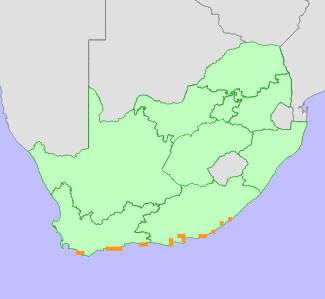|
Scientific Name | Limonium linifolium (L.f.) Kuntze |
Higher Classification | Dicotyledons |
Family | PLUMBAGINACEAE |
National Status |
Status and Criteria | Near Threatened B2b(ii,iii) |
Assessment Date | 2020/11/27 |
Assessor(s) | N.A. Helme & D. van der Colff |
Justification | Limonium linifolium is a widespread, but localized habitat specialist of estuaries and coastal pans, with an extent of occurrence (EOO) of 38 869 km², and an area of occupancy (AOO) of less than 800 km². Although still fairly common and estimated to occur at between 15 and 20 locations, it is declining due to ongoing habitat degradation. It is listed as Near Threatened. |
Distribution |
Endemism | South African endemic |
Provincial distribution | Eastern Cape, Western Cape |
Range | This species is endemic to South Africa, and is found from Gansbaai to Kei Mouth. |
Habitat and Ecology |
Major system | Terrestrial |
Major habitats | Subtropical Seashore Vegetation, Goukamma Dune Thicket, Grass Ridge Bontveld, Hartenbos Dune Thicket, Kasouga Dune Thicket, Sundays Mesic Thicket, Hamburg Dune Thicket, St Francis Dune Thicket, Bethelsdorp Bontveld, Cape Seashore Vegetation, Blombos Strandveld, Subtropical Dune Thicket, Transkei Coastal Belt, Knysna Sand Fynbos, Southern Cape Dune Fynbos, Agulhas Sand Fynbos, Albertinia Sand Fynbos, Overberg Dune Strandveld, Albany Alluvial Vegetation |
Description | It occurs on coastal saline pans and estuaries. |
Threats |
| Many estuaries within the known range of this species are in poor condition (Driver et al. 2012), as a result of infrastructure development, pollution, and upstream damming of rivers. Estuarine ecosystems are poorly protected. Salt processing is causing loss and degradation of saline pans. |
Population |
Limonium linifolium is a localized habitat specialist, but fairly common in suitable habitat along the coast. Many recent records indicate that it persists in many places in spite of habitat degradation, and it may be somewhat resilient to disturbance.
|
Population trend | Unknown |
Assessment History |
Taxon assessed |
Status and Criteria |
Citation/Red List version | | Limonium linifolium (L.f.) Kuntze var. linifolium | Least Concern | Raimondo et al. (2009) | | Limonium linifolium (L.f.) Kuntze var. maritimum (Eckl. & Zeyh. ex Boiss.) R.A.Dyer | Least Concern | Raimondo et al. (2009) | |
Bibliography |
Driver, A., Sink, K.J., Nel, J.L., Holness, S., Van Niekerk, L., Daniels, F., Jonas, Z., Majiedt, P.A., Harris, L. and Maze, K. 2012. National Biodiveristy Assessment 2011: An assessment of South Africa's biodiversity and ecosystems. South African National Biodiversity Institute and Department of Environmental Affairs, Pretoria.
Dyer, R.A. 1963. Plumbaginaceae. In: R.A. Dyer, L.E. Codd and H.B. Rycroft (eds). Flora of southern Africa 26 (Myrsinaceae-Apocynaceae):15-31. Botanical Research Institute, Pretoria.
Goldblatt, P. and Manning, J.C. 2000. Cape Plants: A conspectus of the Cape Flora of South Africa. Strelitzia 9. National Botanical Institute, Cape Town.
Manning, J.C. and Goldblatt, P. 2012. Plants of the Greater Cape Floristic Region 1: The Core Cape Flora. Strelitzia 29. South African National Biodiversity Institute, Pretoria.
Raimondo, D., von Staden, L., Foden, W., Victor, J.E., Helme, N.A., Turner, R.C., Kamundi, D.A. and Manyama, P.A. 2009. Red List of South African Plants. Strelitzia 25. South African National Biodiversity Institute, Pretoria.
|
Citation |
| Helme, N.A. & van der Colff, D. 2020. Limonium linifolium (L.f.) Kuntze. National Assessment: Red List of South African Plants version 2024.1. Accessed on 2025/11/05 |
 Comment on this assessment
Comment on this assessment


